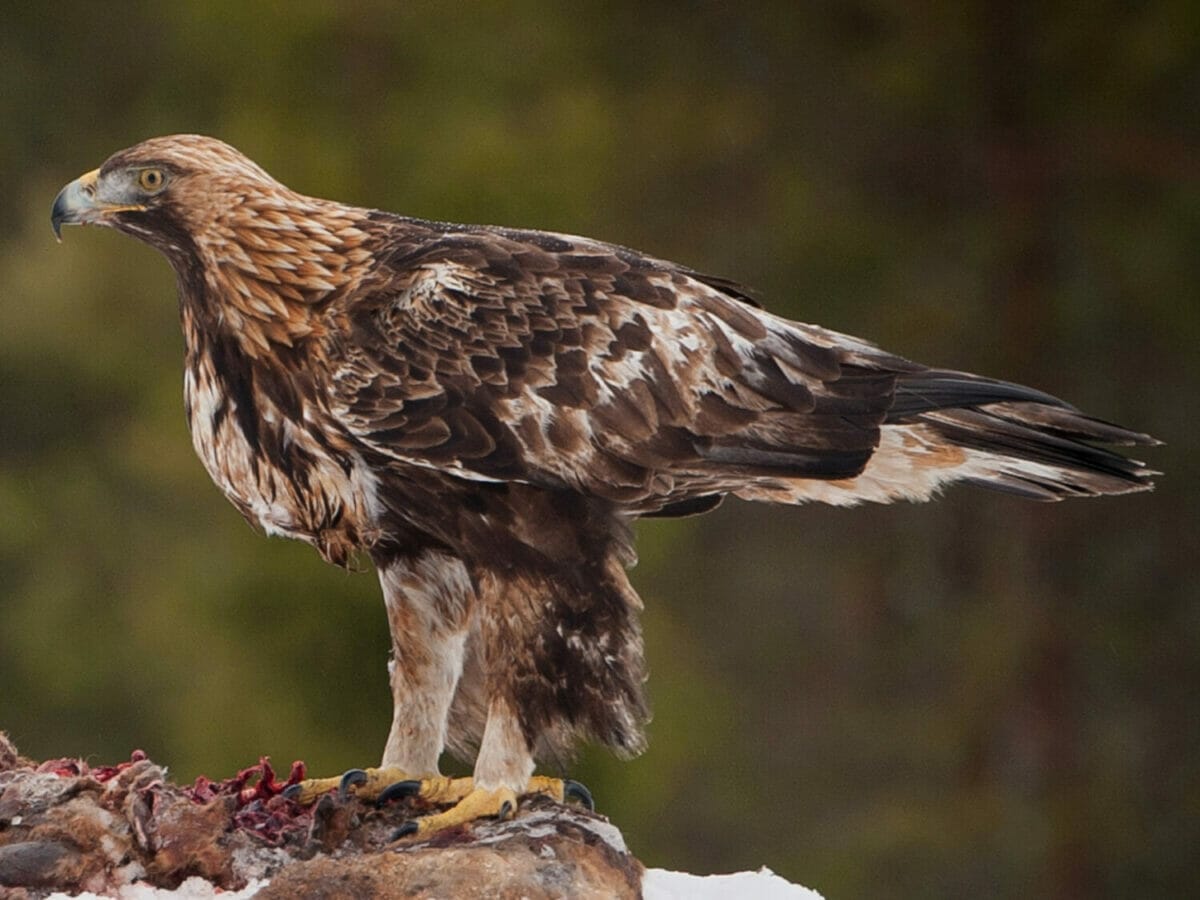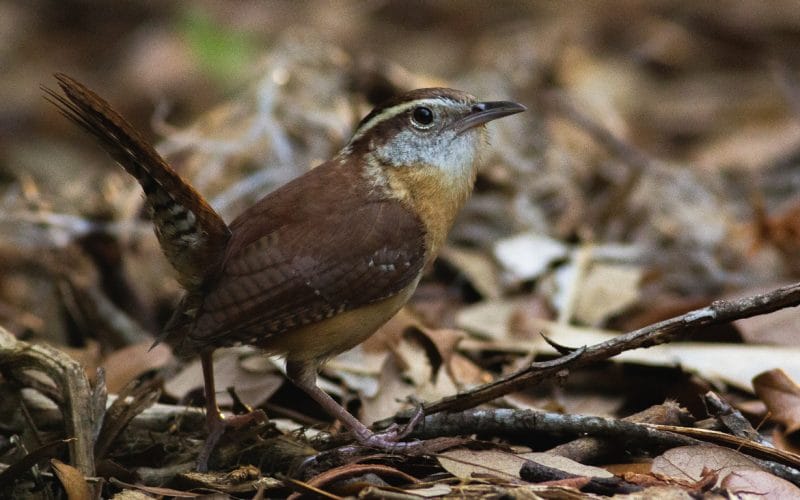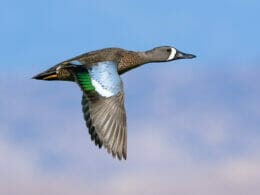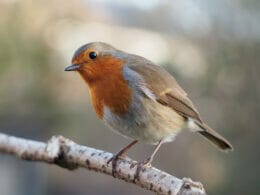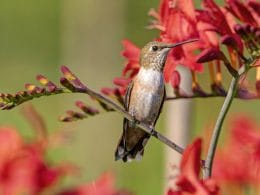Living in Indiana is a cultural-rich experience as it’s home to a lot of famous landmarks and delicious comfort food. But in addition to all the fantastic things you can do in Indiana, there are lots of beautiful birds that might visit your backyard regularly throughout the year.
If you’re interested in the backyard birds of Indiana, read this article to learn more about 17 interesting species that might visit you.
17 Bird Species To Find in Indiana
Indiana is home to more than 6.8 million people who live in more than 2.5 million households. And whether you’re currently living in Indiana or renting a property for a short visit, you can actually see a lot of interesting birds in your backyard. Some of these birds will pass by your backyard once or twice, but some of them will be regular guests at your feeder, as long as you’re providing food and water.
There are currently 422 bird species that you might encounter in Indiana. Some of them are all-year residents, some stay in the state during spring, summer, and early fall, while others visit the state in the cold season.
Here’s a list of the most common birds that you can see in your backyard if you live in Indiana.
1. Northern Cardinal

Many residents in the State of Indiana witness the Northern Cardinal in their backyards and around low shrubs and trees.
Top Tip: The male birds are bright red, while the female ones are a little pale with red-tinged brown plumage.
Although female songbirds rarely sing, female Northern Cardinals share the males their lovely songs.
The official bird of the State of Indiana isn’t a picky eater and will get attracted to any type of feeder you set up in your backyard as long as you fill it with sunflower seeds.
Many birds attack windows because they’re scared of their own reflection.
2. House Finch
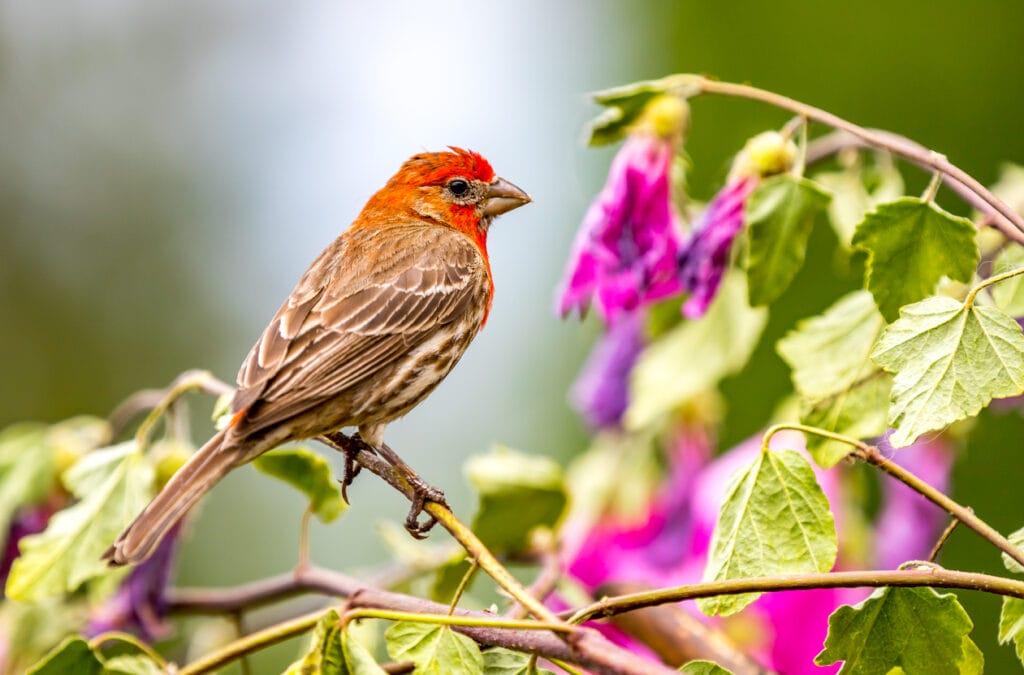
House Finches usually visit backyards in flocks because these social birds enjoy the company of humans.
If you fill your backyard feeder with black oil sunflower seeds, these birds will become regular guests at your property.
It’s easy to identify the House Finch because the male is recognizable, thanks to its rosy red plumage.
It will appreciate the presence of local plants and trees in your backyard because it feeds on fruits, buds, and seeds. The House Finch feeds on mustard seeds, knotweed, apricots, cherries, figs, and blueberries.
3. Mourning Dove

If you hear a haunting, sad call, don’t mistake it for an owl because this might be the Mourning Dove. The Mourning Dove is the same size as a robin and is buffy-tan with black spots that cover the whole body.
Keep an eye on the ground where this bird spends most of its time. It also likes to perch on telephone wires and tree branches.
If you have a cat, make sure that it doesn’t go outside because it can easily attack the Mourning Dove. Scatter some millet on the ground and set up a nesting box to attract a breeding pair.
Some scientists believe that these birds mate for life and actually mourn the loss of a partner.
4. American Goldfinch
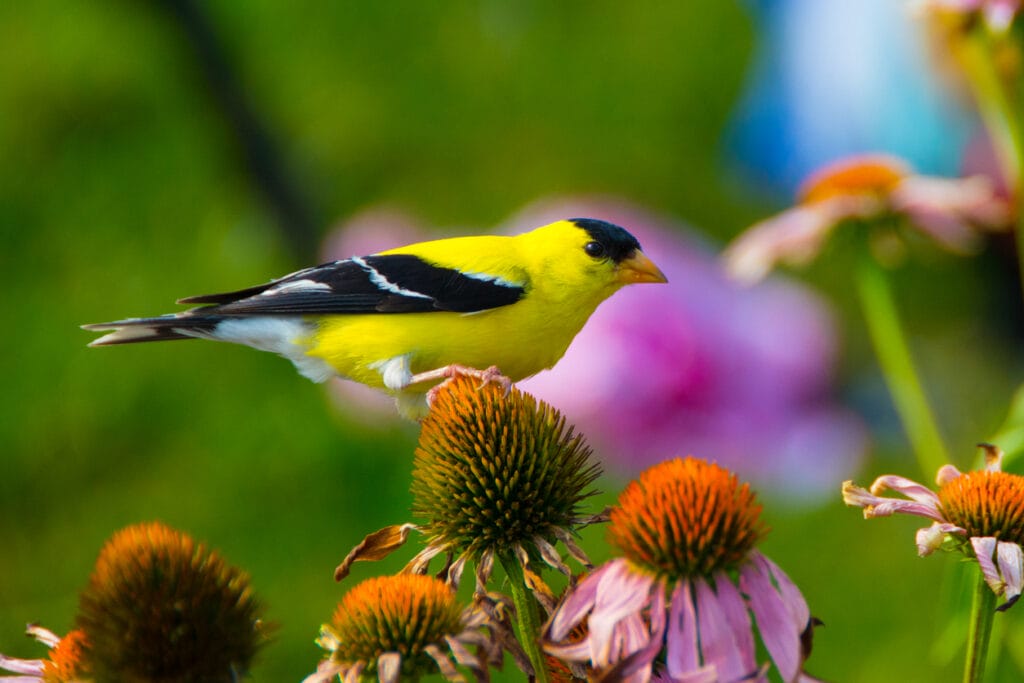
The American Goldfinch is bright yellow with some black markings, and the female birds are slightly paler. This bird is rather active and has an acrobatic flying style, where it clings to weeds and calls other birds while flying for attention.
Unlike other birds, the American Goldfinch doesn’t mind any feeder, including hanging feeders that move with the wind.
Fill your feeder with sunflower seeds and nyjer, and the bird will catch the spilled seeds on the ground.
Author Note: You can also attract this bird by planting native plants like thistles.
5. Pine Siskin
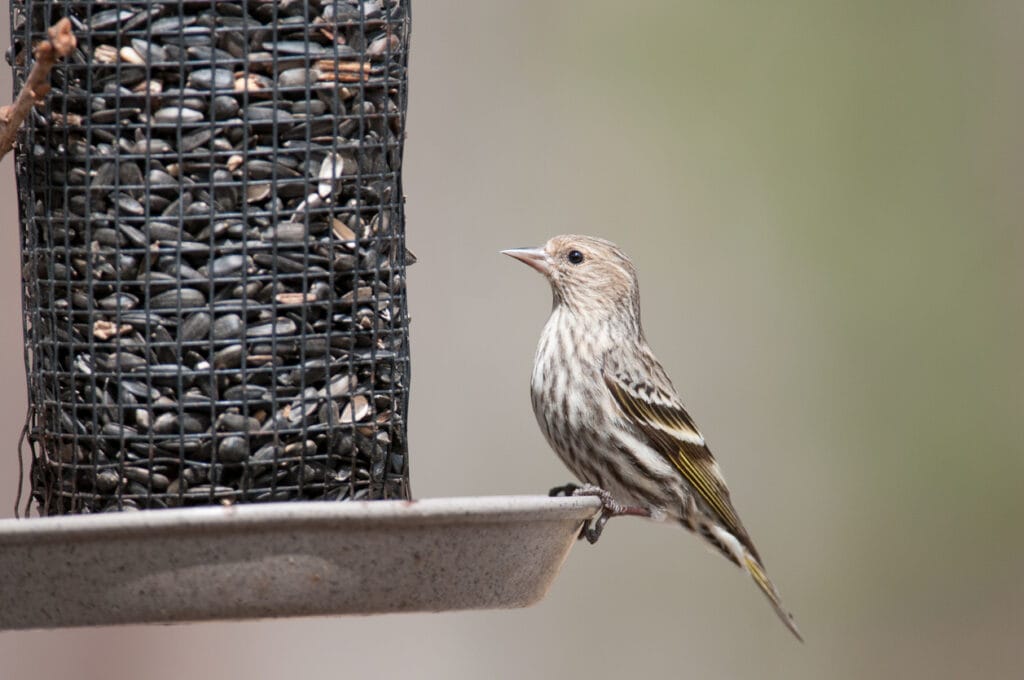
The Pine Siskin can be found in the north during summer, but it moves to South Indiana as the temperature drops.
It’s a small-sized bird that can even be smaller than a sparrow with a streaky brown body and yellow feather endings.
Watch any fallen cones in your backyard as the Pine Siskin will feed on them. It also likes to cling to the endings of conifer branches, so if you’re growing a conifer in your backyard, you might encounter a few birds.
Pine Siskin flocks feed on small seeds at bird feeders like nyjer, thistles, and hulled sunflower seeds.
6. Eastern Bluebird
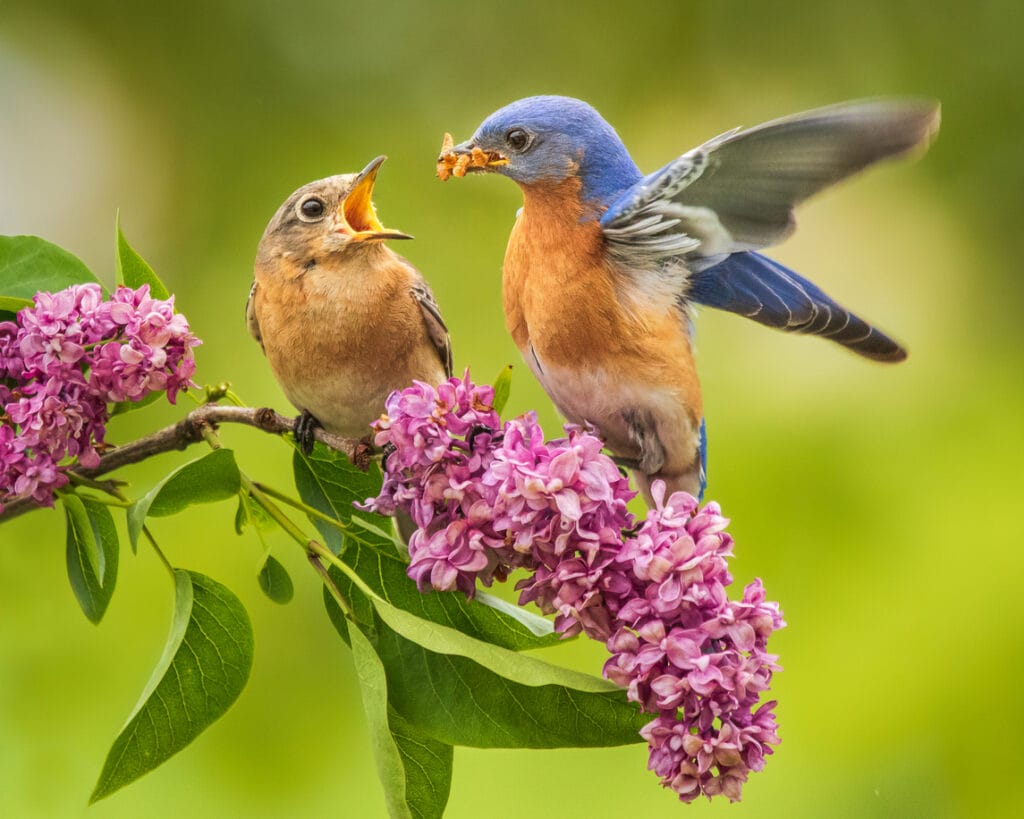
The vivid deep blue plumage of the Eastern Bluebird is one of its most distinctive traits. Male birds might look blue-gray from a distance, while female birds are grayish with blue wings. The birds have red or orange chests.
The Eastern Bluebird might be found sitting on power lines, telephone wires, or fences. It doesn’t visit backyards unless you offer mealworm at your feeder.
It also accepts nest boxes, especially if your backyard isn’t surrounded by too many houses or tall trees.
Lots of bird lovers enjoy watching the male bird as it attracts the female to a nest cavity.
7. White-Throated Sparrow

The White-Throated Sparrow is brown and gray with a striped head. It’s easily identified by its bright white throat and yellow patch around the eyes.
Look for this small brown bird on bushy edges or on the ground in your backyard, but remember to keep your pet cat inside if you don’t want it to catch some of these amazing birds. A cautious perching bird might give out a loud, sharp note to notify other birds of danger.
Author Note: The White-Throated Sparrow visits millet and sunflower seed feeders or pecks at the fallen seeds. Keeping a brush pile in the backyard will attract more members of this species.
8. Tufted Titmouse

Thanks to its large head and eyes, the Tufted Titmouse might actually look bigger than it really is, especially compared to smaller birds that regularly visit your backyard.
It has a silvery gray above, with a white below and a black patch above the bill.
It flies in flocks with chickadees and woodpeckers and is a skilled forager.
Filling your backyard feeder with suet, peanuts, and sunflower seeds will definitely attract the Tufted Titmouse. You can also set up a nesting box for this cavity-nester.
9. Red-Bellied Woodpecker

The Red-Bellied Woodpecker has a boldly striped black and white back with a bright red cap and nape. It can be found on the branches of medium and large trees, and you can hear its call in spring and summer.
Your backyard will seem a lot more interesting to a Red-Bellied Woodpecker if you have some dead trees, as this bird loves to forage for the insects hiding in the bark. It might also excavate a nest.
In winter, the Red-Bellied Woodpecker will spend more time in your backyard if you offer suet and peanuts at your feeder.
10. Red-Winged Blackbird
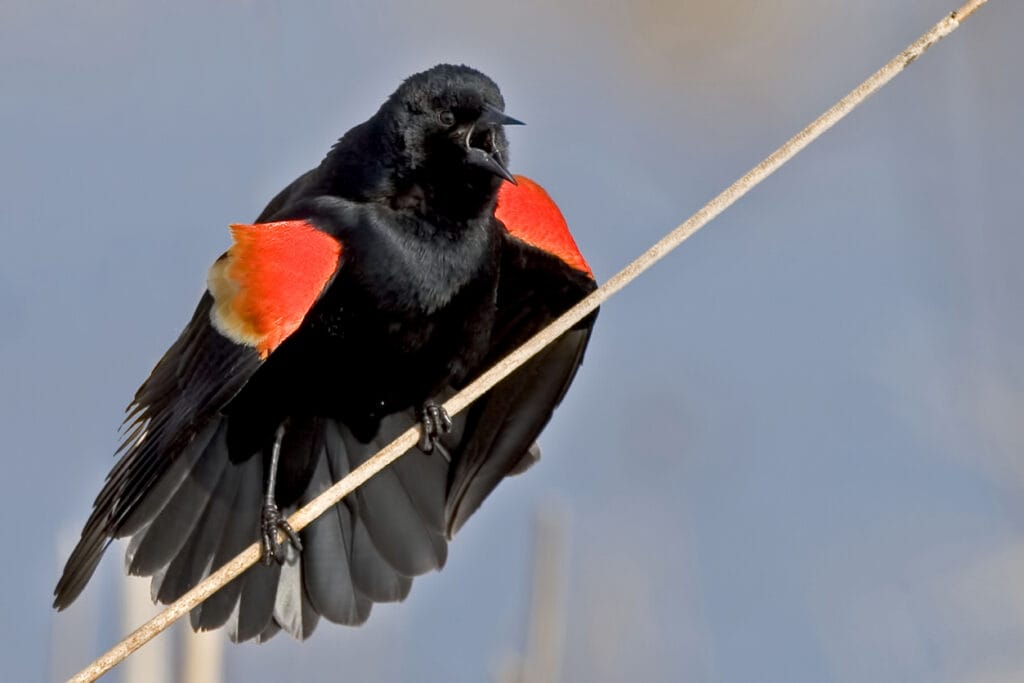
It’s no surprise that you can see this bird in your backyard, as it’s one of the most abundant birds in North America. Males have black glossy feathers and yellow or scarlet shoulder patches that might be obvious or difficult to see, depending on the bird’s sense of security.
This isn’t a shy bird and will try to grab your attention when it’s perching on telephone wires. The Red-Winged Blackbird also has a distinctive loud call.
The migration season is your best chance to watch out for this bird in your backyard. It usually visits backyard feeders for mixed grains and seeds. But be careful because this territorial bird usually engages in fights.
11. American Robin
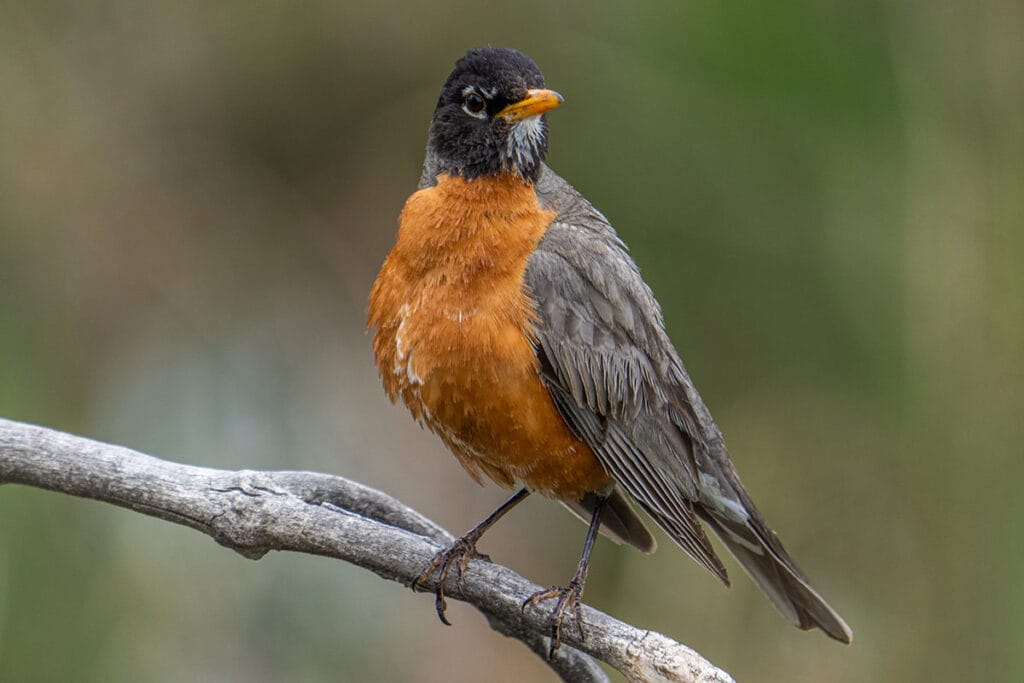
The American Robin is a gray-brown bird with a darker head and red-brown underpants. It’s one of the most common birds that you can find in the lawns of Indiana, where it likes to look for earthworms.
Top Tip: It will visit your bird feeder if you fill it with freshly cut fruits and mealworm, especially in the breeding season.
During spring and summer, the American Robin will appreciate the presence of fruit trees in your backyard, as it loves to feed on juniper and dogwood berries. It often looks for fruits with bugs in them.
12. White-Breasted Nuthatch

The White-Breasted Nuthatch is a small bird with gray-blue plumage, a frosty white face, and a black cap. It gets its name from the habit of hiding large nuts into the bark of trees.
The White-Breasted Nuthatch prefers large nuts like sunflower and peanuts despite its small size. Fill your backyard feeder with them and add some suet, and it will become a regular guest.
In winter, this bird doesn’t mind cooperating with chickadees and other birds to look for food.
13. House Sparrow

As the name suggests, House Sparrows are commonly found in urban areas, where the birds can be seen hopping on the ground. They don’t even mind coming close enough to be fed by hand.
There’s a little variation in the coloring of the females and males, as the male bird has a gray head, white cheeks, and a rufous neck.
Top Tip: The female bird is buffy-brown, and both genders have striped buff, black, and brown backs.
You don’t actually have to set up a feeder to attract the House Sparrow to your backyard, as some discarded food will be enough. It will appreciate any birdseed you offer, especially sunflower seeds, millet, and corn.
14. Purple Finch
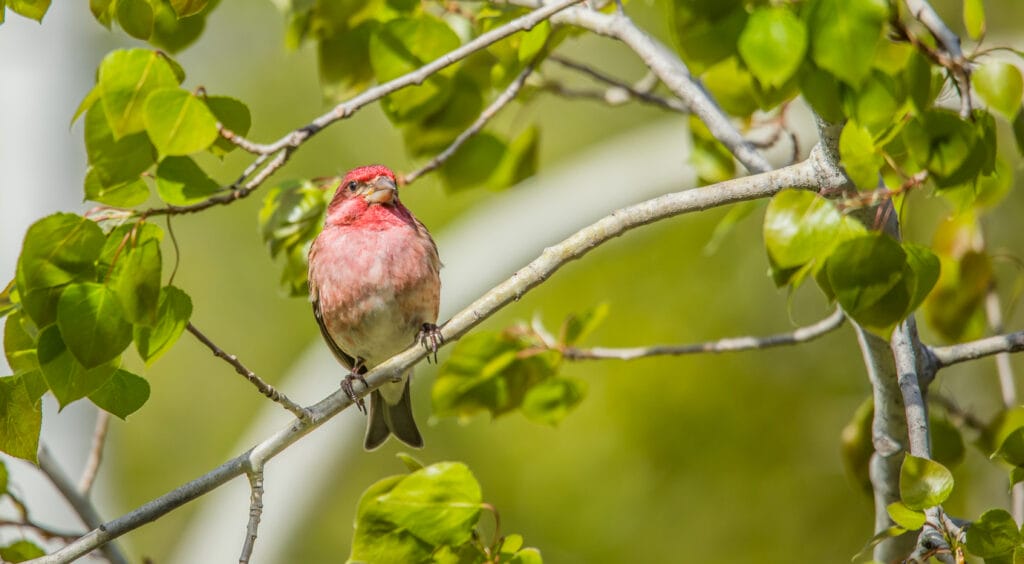
The Purple Finch is common to find in Indiana during winter. The male Purple Finch has a dark pink-red head and breast, with some brown on the back, while the female bird has a striped brown body.
Black oil sunflower seeds are this bird’s favorite, and it uses its large beak to crack them open. It might be confused with the House Finch, which is more common to find but is more reddish.
It sometimes imitates the sounds of other species like American Goldfinches, Barn Swallows, and Brown-Headed Cowbirds.
15. Downy Woodpecker

The Downy Woodpecker has a checkered black and white back, and the male birds have a red patch on the head. It can be found in residential areas, and you won’t miss its high-toned call.
This woodpecker is a common guest at backyards and prefers to eat suet offered at feeders. However, it won’t mind if you offer black oil sunflower seeds, millet, peanuts, and even chunky peanut butter.
In winter, it will fly with other species as these help the birds spend more time looking for food and less time watching out for predators.
16. Ruby-Throated Hummingbird

The Ruby-Throated Hummingbird is a small bird that won’t be easily missed, thanks to its brilliant plumage.
The bird is bright emerald or golden-green with white-gray underpants. Male birds are known for their shiny red throats.
Lots of bird lovers love to watch this bird’s intriguing flying style. It flies fast, stops suddenly, and then hovers to adjust its direction. It will be attracted to your property if you have a flower garden where you grow native tubular trees.
Setting up a hummingbird feeder will definitely attract the attention of the Ruby-Throated Hummingbird.
Prepare homemade nectar from sugar and water, and change it frequently to avoid the fermentation of sugar because it can intoxicate the birds.
17. Dark-Eyed Junco

The Dark-Eyed Junco is usually dark gray with a pink bill and white outer tail feathers. It spends most of its time on the ground, exploring lawns or looking for fallen seeds.
This little bird is also known as the Snow Bird in Indiana because it arrives in winter, where it’s usually seen around November.
It often visits bird feeders to feed on seeds, which represent 75% of the bird’s diet.
Top Tip: The Dark-Eyed Junco prefers millet and sunflower seeds. It doesn’t mind nesting in or underneath buildings.
Wrap Up
You don’t have to leave the house to study the amazing birds in Indiana, as many of them won’t mind visiting your backyard. Some birds will even start building their nests on your property.
Some of these birds are extremely shy, while others will announce their presence throughout the year.
So keep an eye on your backyard and provide fresh food and water to attract these beautiful creatures.
FAQ
The Northern Cardinal is probably the most common bird in Indiana. It is quite amazing that such a stunning bird is so easily seen! It is also the state bird.
The Peregrine Falcon is the fastest bird on the planet, not just Indiana. As it dives, it can reach 200 miles per hour.
The Barred Owl has a repertoire of calls and one of them sounds like a monkey howling.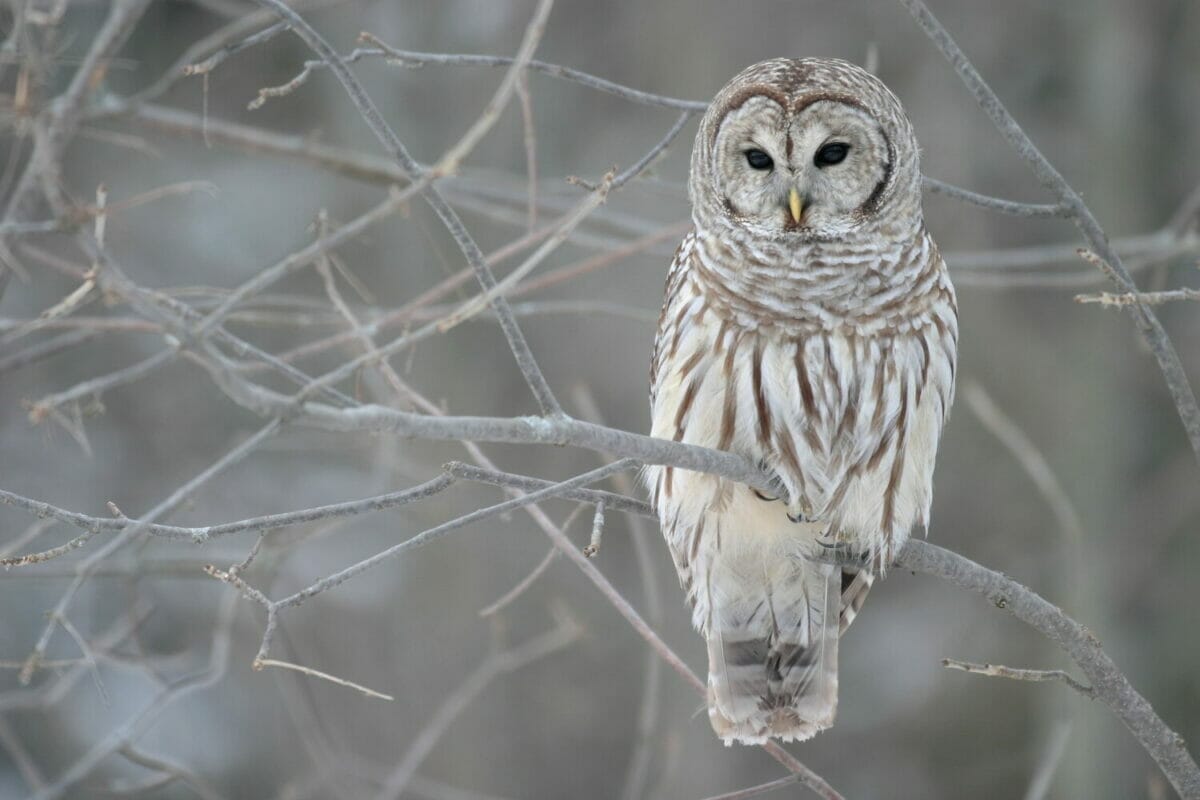
Yes, they spend winters in the mid-west before returning to Canada to breed in the summer. 